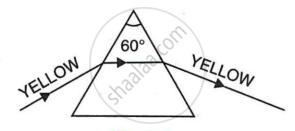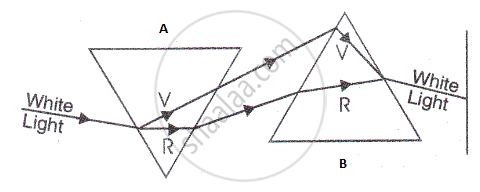Advertisements
Advertisements
प्रश्न
The frequency range of visible light is from 3.75 × 1014 Hz to 7.5 × 1014 Hz. Calculate its wavelength range. Take speed of light = 3 × 108 m/s.
उत्तर
Frequency f = 3.75 × 1014 Hz
Velocity of light (C) = 3 × 108 m/s
λ = `C/f`
= `(3 xx 10^8)/(3.75 xx 10^14)`
= `(3000 xx 10^5)/(375 xx 10^12)`
λ = `(8 xx 10^5)/(10^12)`
= `8 × 10^(5 - 12)`
= 8 × 10-7 m
= 8 × 10-7 × 1010 Å
= `8 × 10^(-7+10)`
= 8 × 103 Å
Also, f = 7.5 × 1014 Hz
λ = `C/f`
= `(3 xx 10^8)/(7.5 xx 10^14)` m
= `(3 xx 10^8)/(75 xx 10^13)` m
= `(300)/(75) xx (10^6)/(10^13)`
= `4 × 10^(6 - 13)`m
= 4 × 10-7
= `4 xx 10^(-7 + 10)`
= 4 × 103
= 4000 Å
∴ Wavelength range of visible light is 4000 Å to 8000 Å
APPEARS IN
संबंधित प्रश्न
Make two diagrams to explain refraction and dispersion.
Describe how you could demonstrate that white light is composed of a number of colours.
What acts as tiny prisms in the formation of a rainbow?
Which of the following colour of white light has the least wavelength?
(a) red
(b) orange
(c) violet
(d) blue
The seven colours in the spectrum of sunlight in order, are represented as :
The diagram below shows the path taken by a narrow beam of yellow monochromatic light passing through an equiangular glass prism. If the yellow light is replaced by a narrow beam of white light incident at the same angle, draw another diagram to show the passage of white light through the prism and label it to show the effect of prism on the white light.

Complete the ray diagram given below to show the nature of light produced on the screen.
The completed ray diagram is as shown below:

An object is placed in front of a converging lens and in front of a diverging lens as in fig.

(a)Complete the ray diagram to obtain an image.
(b)Compare the nature of image formed by both the lenses in the above case.
The wavelength range of white light is ______.
Assertion: We can see the rainbow in the sky when the rain starts falling after a spell of bright sunlight.
Reason: The rainbow is formed due to the dispersion of light.
